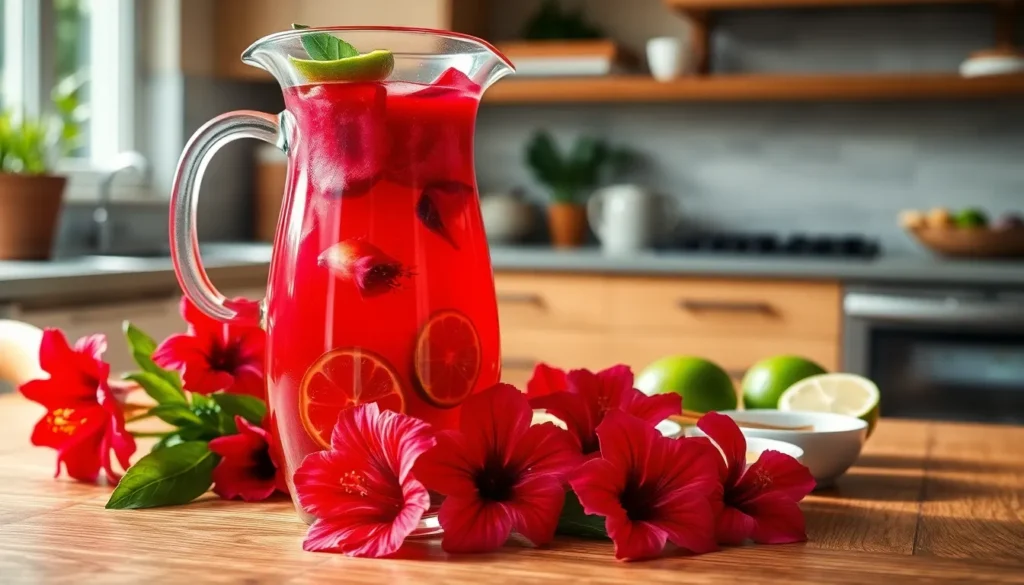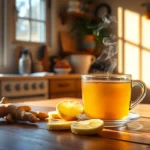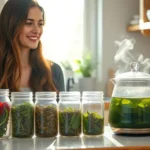We’ve discovered something incredible about hibiscus tea that’ll transform your beverage game forever. This ruby-red powerhouse isn’t just gorgeous to look at – it’s packed with antioxidants and delivers a tart cranberry-like flavor that’s absolutely addictive. Originally treasured in ancient Egypt and now beloved worldwide, hibiscus tea offers endless possibilities for creative brewing.
What makes hibiscus tea truly special is its versatility. We can serve it hot as a soothing evening ritual or ice-cold as a refreshing summer cooler. The dried petals steep into the most stunning crimson color you’ve ever seen, creating Instagram-worthy drinks that taste even better than they look.
We’re about to share our favorite hibiscus tea recipes that’ll have you brewing like a pro. From classic preparations to exciting flavor combinations with ginger, mint, and citrus, these recipes will help you unlock hibiscus tea’s full potential and create beverages that’ll impress everyone.
What Is Hibiscus Tea
Hibiscus tea comes from the dried petals of the hibiscus flower, specifically the Hibiscus sabdariffa plant. We know this vibrant ruby red beverage by many names including sorrel tea, red zinger, and agua de jamaica in Latin American countries.
The flower petals contain natural compounds called anthocyanins that give the tea its stunning crimson color. These same compounds provide powerful antioxidant benefits that support our overall health and wellness.
We appreciate hibiscus tea for its naturally tart and cranberry-like flavor profile. The taste balances beautifully between tangy and slightly sweet without any added sugars or artificial ingredients.
This caffeine-free herbal tea offers us flexibility in preparation methods. We can brew it hot for a warming winter drink or steep it cold for refreshing summer beverages. The brewing process remains simple whether we choose traditional hot steeping or cold brewing techniques.
Hibiscus flowers grow in tropical and subtropical regions around the industry. Major growing areas include Sudan, Egypt, Thailand, Mexico, and parts of the Caribbean where the climate supports year-round cultivation.
The preparation involves harvesting the flower calyces at peak ripeness then carefully drying them to preserve their color and nutritional properties. We find that properly dried hibiscus petals maintain their vibrant appearance and robust flavor for extended storage periods.
Traditional medicine systems have used hibiscus tea for centuries across different cultures. Many communities incorporated this floral beverage into daily routines and special celebrations long before modern research confirmed its health benefits.
Health Benefits of Hibiscus Tea
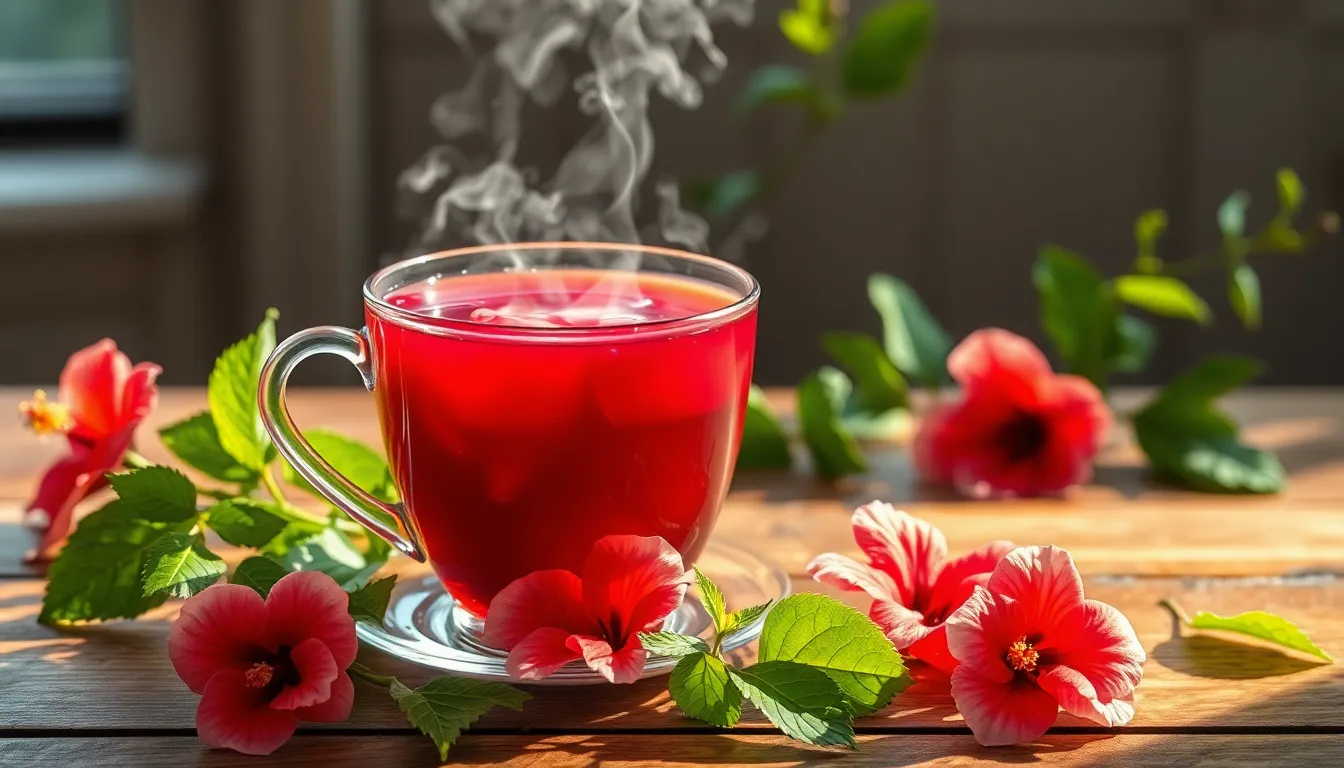
Beyond its stunning appearance and refreshing taste, hibiscus tea delivers impressive health benefits that make this vibrant beverage even more appealing. We’ve discovered that regular consumption of hibiscus tea can support overall wellness in multiple ways.
Powerful Antioxidant Protection
Hibiscus tea contains exceptionally high levels of antioxidants that help combat oxidative stress throughout our bodies. These protective compounds work tirelessly to neutralize harmful free radicals and support cellular health. The same anthocyanins responsible for the tea’s beautiful crimson color provide important antioxidant benefits that may help reduce inflammation and protect against chronic diseases.
Blood Pressure Management
Research studies suggest that hibiscus tea may effectively lower high blood pressure when consumed regularly. We find this particularly noteworthy since cardiovascular health remains a primary concern for many people. The natural compounds in hibiscus flowers appear to support healthy blood pressure levels through their gentle yet effective properties.
Cholesterol Reduction Support
Several studies indicate that hibiscus tea may help reduce LDL cholesterol levels in our bodies. This cholesterol-lowering potential adds another layer of cardiovascular support to the tea’s impressive health profile. Regular consumption could contribute to better heart health when combined with a balanced diet and healthy lifestyle.
Liver Health Benefits
Some research points to hibiscus tea’s potential for supporting liver protection and function. Our liver works constantly to filter toxins and process nutrients, making any natural support particularly valuable. The protective compounds in hibiscus may help maintain optimal liver health over time.
Digestive and Detox Support
Hibiscus tea acts as a mild diuretic and digestive aid, supporting our body’s natural detoxification processes. This gentle effect helps promote healthy digestion without causing harsh side effects. The tea’s natural properties work harmoniously with our digestive system to support overall wellness.
Caffeine-Free Benefits
Unlike traditional teas, hibiscus tea contains no caffeine, making it suitable for those avoiding stimulants or seeking an evening beverage. We appreciate that this allows us to enjoy hibiscus tea throughout the day without concerns about sleep disruption or caffeine sensitivity. This caffeine-free nature makes hibiscus tea an excellent choice for people of all ages and dietary preferences.
Essential Equipment and Tools

Making hibiscus tea requires minimal equipment, but having the right tools ensures the best brewing results. We recommend starting with these basic items that most home cooks already have in their kitchen.
Primary Brewing Equipment
Tea Kettle or Pot serves as the foundation for hot hibiscus tea preparation. Glass or stainless steel options work best because they don’t affect the tea’s delicate flavor profile. We find that a medium-sized kettle handles most batch sizes perfectly.
Tea Infuser, Strainer, or Filter becomes essential when working with loose hibiscus flowers. These tools contain the dried petals during steeping while allowing maximum flavor extraction. Fine mesh strainers work excellently for this purpose, though reusable tea bags offer convenient cleanup.
Heat-Resistant Pitcher or Measuring Cup proves invaluable for larger batches and cold brewing methods. Pyrex measuring cups handle temperature changes well and provide clear visibility of the tea’s beautiful crimson color as it develops.
Supporting Tools
Spoon or Spatula helps with stirring and incorporating sweeteners evenly throughout the tea. We prefer wooden spoons that won’t scratch delicate glassware or react with the tea’s natural acids.
Serving Vessels complete the setup with glasses, mugs, or tumblers depending on your serving preference. Clear glass showcases hibiscus tea’s stunning visual appeal.
Optional Equipment for Enhanced Brewing
| Tool | Purpose | Benefit |
|---|---|---|
| Kitchen Scale | Precise measurements | Consistent flavor every batch |
| Fun Spoon | Portioning dried flowers | Accurate serving sizes |
| Reusable Tea Filter | Loose leaf containment | Eco-friendly brewing option |
These tools create the perfect foundation for exploring all the hibiscus tea variations we’ll share in the following recipes. Most home brewers find that basic equipment produces excellent results, while optional tools simply enhance precision and convenience.
Basic Hibiscus Tea Ingredients
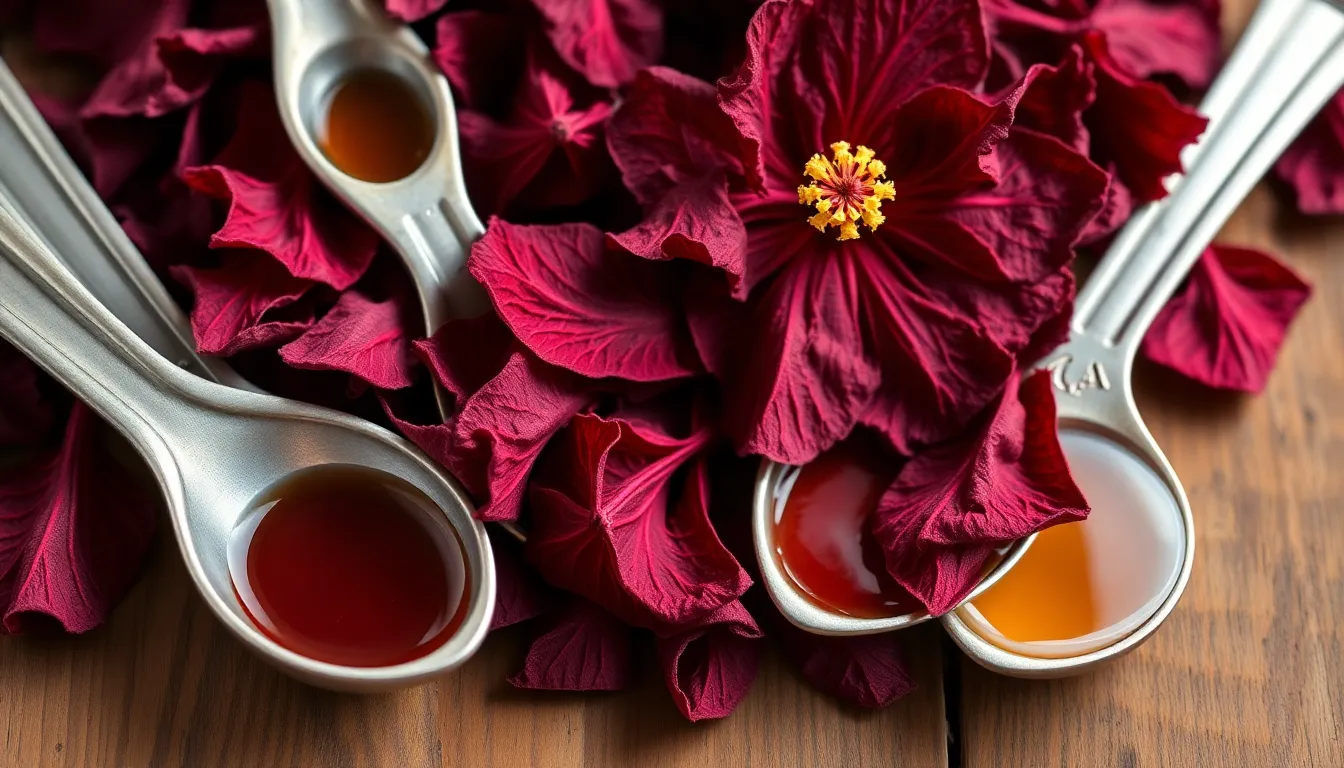
Creating the perfect cup of hibiscus tea starts with selecting quality ingredients that complement the flower’s natural tartness. We’ll guide you through the essential components that form the foundation of every delicious hibiscus tea recipe.
Dried Hibiscus Flowers
The star ingredient for our hibiscus tea is dried hibiscus flowers, also known as “flor de Jamaica.” We recommend using a standard ratio to achieve the perfect balance of flavor and strength in your brew.
| Ingredient | Water Amount | Hibiscus Flowers |
|---|---|---|
| Standard Ratio | 6-8 cups | ½-¾ cup dried flowers |
Quality dried hibiscus flowers should display a deep burgundy color and retain their natural floral aroma. We source our hibiscus from reputable suppliers to ensure maximum flavor extraction and vibrant color development. The flowers expand significantly during steeping, so we always allow adequate space in our brewing vessel.
Sweeteners and Flavor Enhancers
Balancing the natural tartness of hibiscus requires thoughtful sweetening to enhance rather than mask the flower’s unique flavor profile. We use various sweeteners depending on our taste preferences and dietary needs.
Primary Sweeteners:
- Sugar (white or brown)
- Honey (raw or processed)
- Agave nectar
- Maple syrup
| Batch Size | Sweetener Amount | Notes |
|---|---|---|
| Large batch (6-8 cups) | ¼-1 cup | Adjust to taste preference |
| Individual serving | 1-2 teaspoons | Start with less, add more as needed |
Citrus Enhancers:
We add fresh lime juice or lemon juice just before serving to brighten the tea’s natural acidity. The recommended amount is 2-3 tablespoons per large batch, though we adjust this based on the citrus fruit’s natural tartness.
Optional Add-Ins
Customizing hibiscus tea with complementary flavors allows us to create unique variations that suit different moods and occasions. We incorporate these add-ins during the steeping process or use them as finishing garnishes.
Warming Spices:
- Cinnamon sticks
- Ground cloves
- Nutmeg
- Allspice
Fresh Herbs:
- Fresh mint leaves
- Basil
- Lemongrass
- Lemon zest
Preparation Notes:
We steep hardy spices like cinnamon sticks and whole cloves alongside the hibiscus flowers for maximum flavor infusion. Delicate herbs such as mint and basil are added during the final minutes of steeping to preserve their bright, fresh qualities. Fresh garnishes like citrus slices and herb sprigs are reserved for serving to maintain visual appeal and aromatic impact.
Classic Hot Hibiscus Tea Recipe
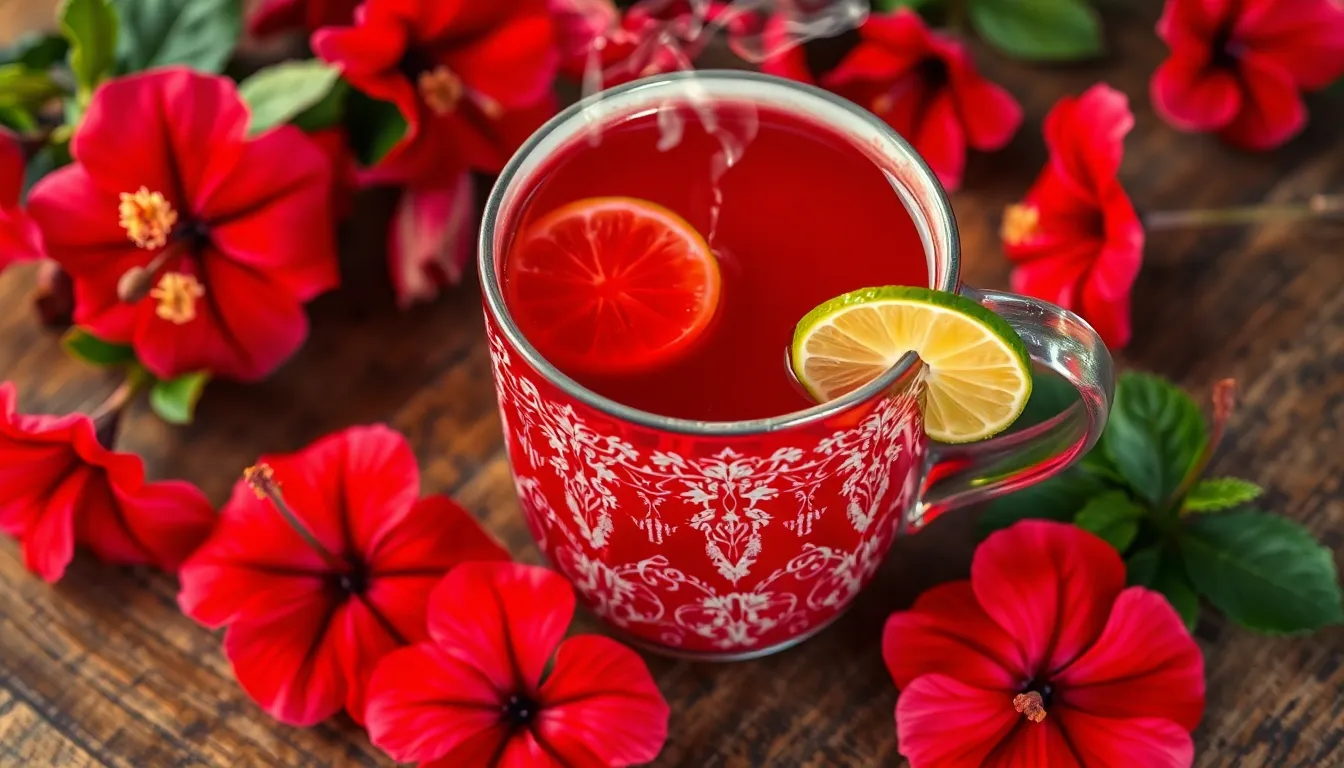
We’ll guide you through preparing the perfect hot hibiscus tea that showcases the flower’s vibrant crimson color and tart cranberry-like flavor. This traditional brewing method delivers maximum antioxidant benefits while creating a satisfying warm beverage.
Ingredients
- Dried hibiscus flowers: 1/4 cup
- Water: 4 cups
- Honey, sugar, or maple syrup: To taste (optional)
- Fresh lime juice or lemon zest: For flavor enhancement (optional)
Instructions
- Bring water to a boil in a medium saucepan over high heat.
- Add dried hibiscus flowers to the boiling water and immediately reduce heat to low.
- Cover the saucepan and allow the mixture to steep for 15-20 minutes. The liquid will transform into a beautiful deep red color as the flowers release their vibrant pigments.
- Strain the tea using a fine-mesh strainer to remove all hibiscus petals. Press the flowers gently against the strainer to extract any remaining liquid.
- Sweeten to taste by stirring in your preferred sweetener while the tea remains hot. The natural tartness pairs beautifully with honey or maple syrup.
- Enhance with citrus by adding fresh lime juice or lemon zest according to your preference. Start with a small amount and adjust to balance the tea’s inherent tanginess.
- Serve immediately in heat-resistant cups or mugs. Garnish with a lime wheel or fresh mint sprig for an elegant presentation.
Steeping Time Guidelines:
| Duration | Flavor Profile | Recommended Use |
|---|---|---|
| 10-12 minutes | Mild, delicate | First-time drinkers |
| 15-20 minutes | Balanced, robust | Standard preparation |
| 25+ minutes | Strong, potentially bitter | Avoid extended steeping |
Store any leftover tea in the refrigerator for up to one week. Reheat gently on the stovetop or enjoy cold as a refreshing iced beverage.
Iced Hibiscus Tea Recipe
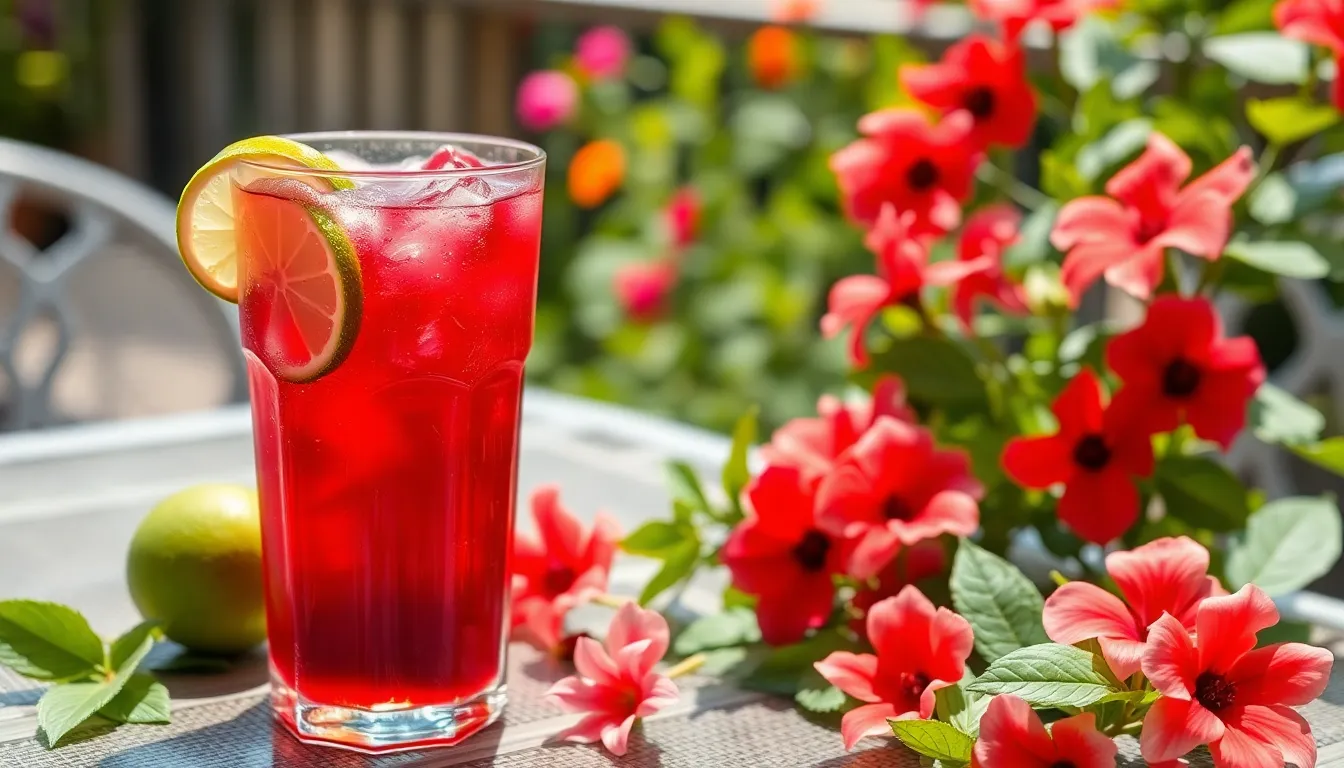
When temperatures rise we turn to refreshing iced hibiscus tea to beat the heat. This chilled version transforms the tangy crimson beverage into a perfect summer refresher.
Ingredients
- ¼ cup dried hibiscus flowers
- 4 cups cold filtered water
- Ice cubes for serving
- 2-3 tablespoons sugar or honey (adjust to taste)
- 1 tablespoon fresh lime juice (optional)
- Lime wedges for garnish
Instructions
- Combine hibiscus flowers and cold water in a large glass pitcher or jar. Cold brewing preserves the delicate floral notes while extracting the vibrant ruby color.
- Refrigerate the mixture for 2-4 hours to allow proper infusion. The longer steeping time develops deeper flavor without any bitterness.
- Strain the tea through a fine mesh strainer to remove all hibiscus petals. Press the flowers gently to extract remaining liquid.
- Stir in sweetener while the tea is still concentrated to ensure complete dissolution. Taste and adjust sweetness as needed.
- Add lime juice if desired to enhance the natural tartness and brighten the overall flavor profile.
- Fill glasses with ice cubes and pour the chilled hibiscus tea over the ice.
- Garnish with lime wedges and serve immediately for the most refreshing experience.
Store any leftover iced hibiscus tea in the refrigerator for up to 3 days. The tea may separate slightly but simply stir before serving to redistribute the flavors.
Hibiscus Ginger Tea Recipe
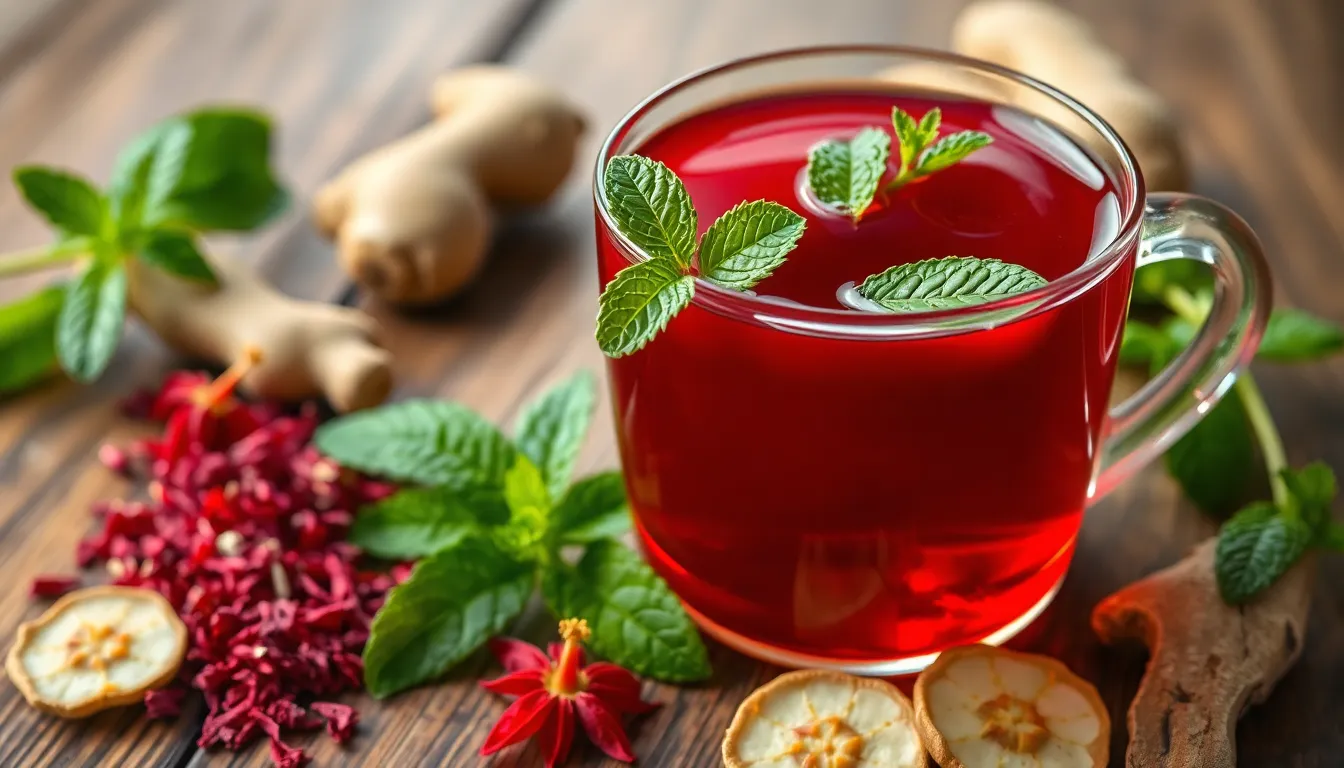
We transform our basic hibiscus tea into a warming and invigorating blend by adding fresh ginger root. This combination creates a perfect balance between the tart floral notes of hibiscus and the spicy warmth of ginger.
Ingredients
- 1/4 cup dried hibiscus flowers
- 1-inch piece fresh ginger, thinly sliced
- 4 cups filtered water
- Sweetener of choice (honey, sugar, or agave nectar)
- Ice cubes for serving
- Fresh mint sprigs for garnish (optional)
Instructions
- Bring water to a rolling boil in a medium saucepan or tea kettle over high heat.
- Add hibiscus flowers to the boiling water and reduce heat to medium-low. Allow the mixture to simmer for 10 minutes until the liquid turns a deep crimson color.
- Incorporate sliced ginger into the simmering tea and continue steeping for an additional 5 minutes. The ginger will infuse its warming properties and create a beautifully balanced flavor profile.
- Remove from heat and strain the tea through a fine-mesh strainer into a heat-resistant pitcher. Press the solids gently to extract maximum flavor before discarding them.
- Sweeten to taste while the tea is still warm for better dissolution. Start with 2-3 tablespoons of your chosen sweetener and adjust according to preference.
- Serve immediately hot in mugs or allow to cool completely before pouring over ice for a refreshing cold version. Garnish with fresh mint sprigs if desired.
Hibiscus Mint Tea Recipe
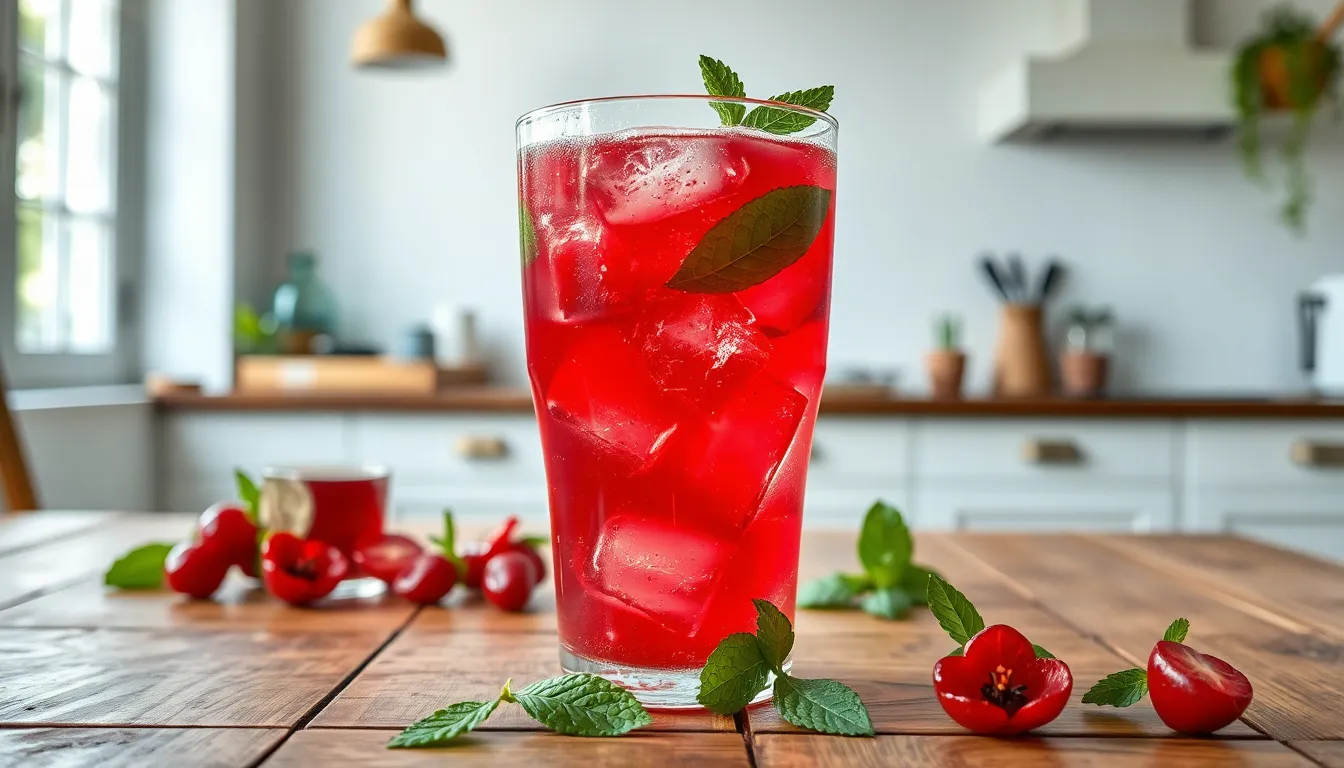
We combine refreshing mint with vibrant hibiscus flowers to create a cooling beverage that perfectly balances tart and aromatic flavors. This delightful variation elevates the classic hibiscus tea experience with fresh herbal notes.
Ingredients
- ¼ cup dried hibiscus flowers
- 4 cups cold filtered water
- Handful of fresh mint leaves
- Ice cubes
- Sweetener of choice (optional)
- Additional fresh mint leaves for garnish
Instructions
- Combine the base ingredients by placing dried hibiscus flowers and fresh mint leaves in a large jar or pitcher with cold filtered water.
- Chill the mixture for at least 20 minutes in the refrigerator. For deeper color and stronger flavor we recommend steeping overnight.
- Strain the tea through a fine mesh strainer to remove all hibiscus flowers and mint leaves.
- Serve over ice by filling glasses with ice cubes and pouring the strained tea over them.
- Sweeten if desired by adding your preferred sweetener and stirring until dissolved.
- Garnish with fresh mint by placing additional mint leaves in each glass for aromatic appeal and visual presentation.
Hibiscus Lemonade Recipe
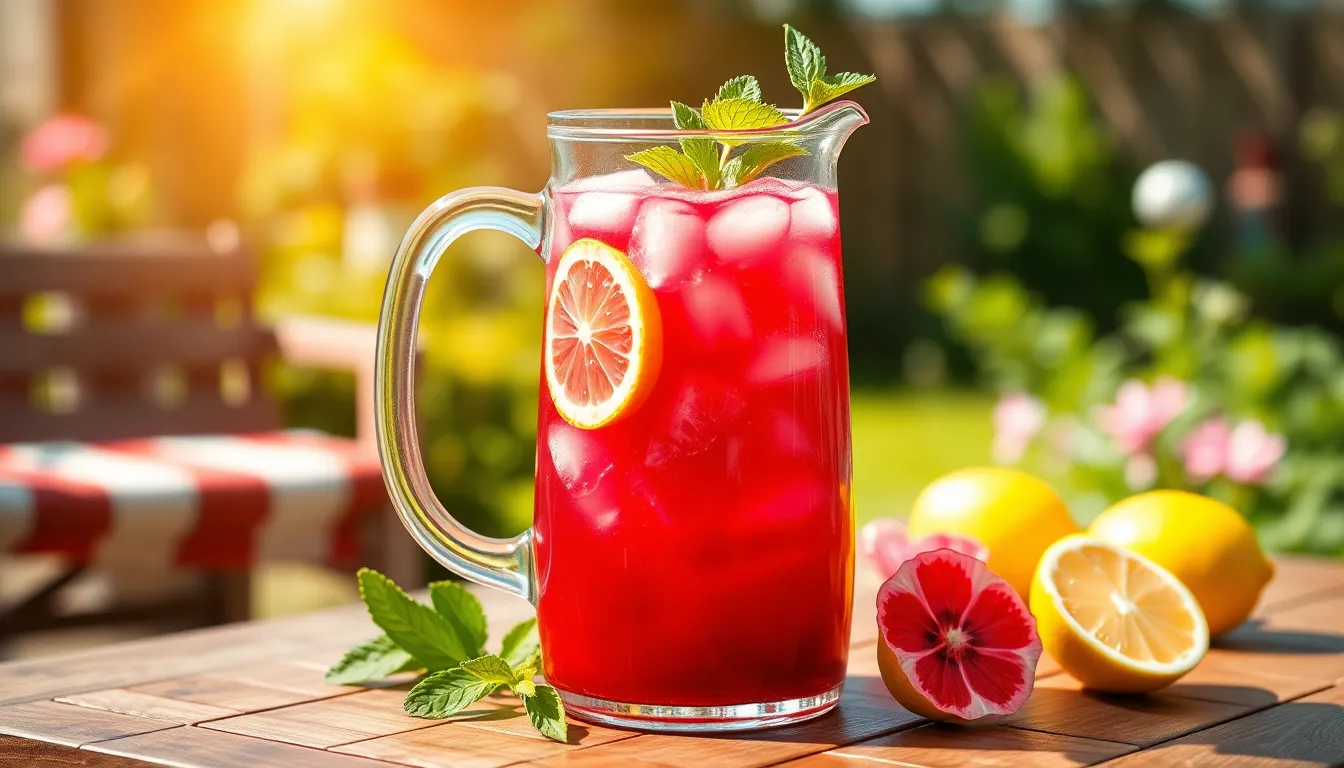
Combining hibiscus tea with fresh lemon juice creates a refreshing summer beverage that balances tart floral notes with bright citrus flavors. This vibrant drink delivers beautiful color and satisfying taste perfect for entertaining or everyday enjoyment.
Ingredients
- 2 cups brewed hibiscus tea, cooled completely
- 1 cup freshly squeezed lemon juice
- 1 cup granulated sugar
- 4 cups cold water
- Ice cubes for serving
- Fresh lemon slices for garnish
- Fresh mint sprigs for garnish (optional)
Instructions
Brew hibiscus tea using your preferred method and allow it to cool completely to room temperature. Transfer the cooled tea to a large pitcher that can hold at least 8 cups of liquid.
Add freshly squeezed lemon juice to the pitcher with the hibiscus tea. Pour in the granulated sugar and stir vigorously until the sugar dissolves completely.
Add cold water to the mixture and stir well to combine all ingredients. Taste the lemonade and adjust sweetness by adding more sugar if desired.
Chill the hibiscus lemonade in the refrigerator for at least 2 hours before serving. Fill glasses with ice cubes and pour the chilled lemonade over the ice.
Garnish each glass with fresh lemon slices and mint sprigs if using. Serve immediately while cold for the best flavor and presentation.
Store leftover hibiscus lemonade in the refrigerator for up to 3 days in a covered pitcher. Stir before serving as ingredients may separate over time.
Hibiscus Green Tea Blend Recipe
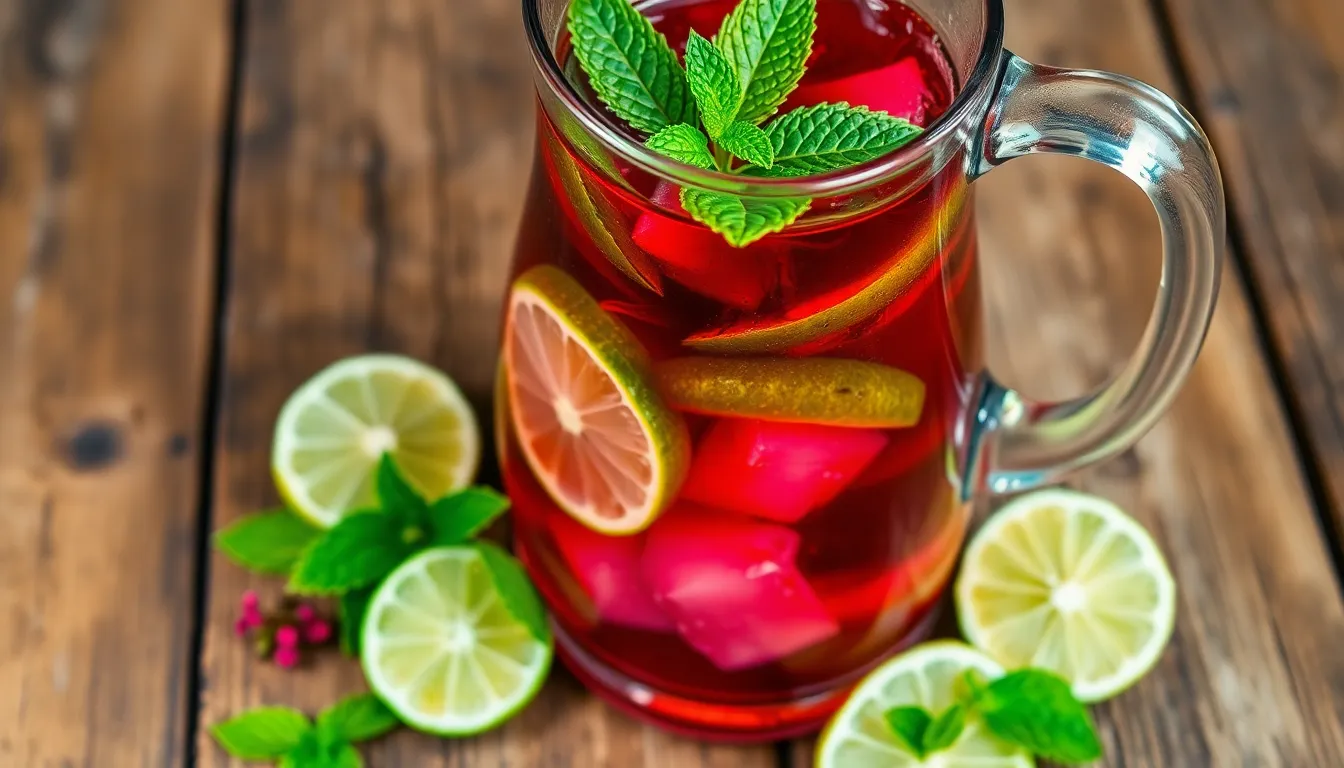
We create this energizing blend by combining the antioxidant power of green tea with hibiscus flowers’ vibrant color and tart flavor. This refreshing fusion offers a caffeine-light option that delivers both wellness benefits and exceptional taste.
Ingredients
- ¼ cup dried hibiscus flowers
- 2 tablespoons green tea leaves (or 2-3 green tea bags)
- 4 cups filtered water
- Ice for serving
- Sweetener of choice (sugar, honey, agave, or maple syrup) – optional
- Fresh mint for garnish – optional
- Lime or lemon slices for garnish – optional
Instructions
Boil Water: We bring 4 cups filtered water to a rolling boil in a medium saucepan.
Steep Hibiscus: After removing from heat we add dried hibiscus flowers to the hot water. Cover and let steep for 10-15 minutes to extract the deep crimson color and tart flavor.
Add Green Tea: We add green tea leaves or tea bags to the hot hibiscus infusion. Steep for an additional 2-3 minutes only to prevent bitterness from over-extraction.
Strain: Pour the mixture through a fine-mesh strainer into a heat-safe pitcher or bowl. We discard the spent flowers and tea leaves completely.
Sweeten: While the tea remains warm we stir in our preferred sweetener. Adjust sweetness level to personal taste preferences.
Cool and Chill: Allow the tea to reach room temperature before transferring to the refrigerator. Chill for at least 1 hour before serving.
Serve: We pour the chilled blend over ice-filled glasses. Garnish with fresh mint sprigs and citrus slices if desired.
| Adjustment Guidelines | Time/Amount |
|---|---|
| Green tea steeping time | 2-3 minutes maximum |
| Hibiscus steeping time | 10-20 minutes for stronger flavor |
| Refrigerator storage | Up to 1 week |
| Caffeine content | Light (adjustable by green tea amount) |
For stronger hibiscus flavor we increase the flowers or extend steeping time up to 20 minutes while keeping green tea separate. Adding warming spices like cinnamon or cloves during hibiscus steeping creates aromatic variations. The caffeine content remains light when using minimal green tea but can be adjusted by varying the amount of green tea leaves used.
Spiced Hibiscus Chai Recipe
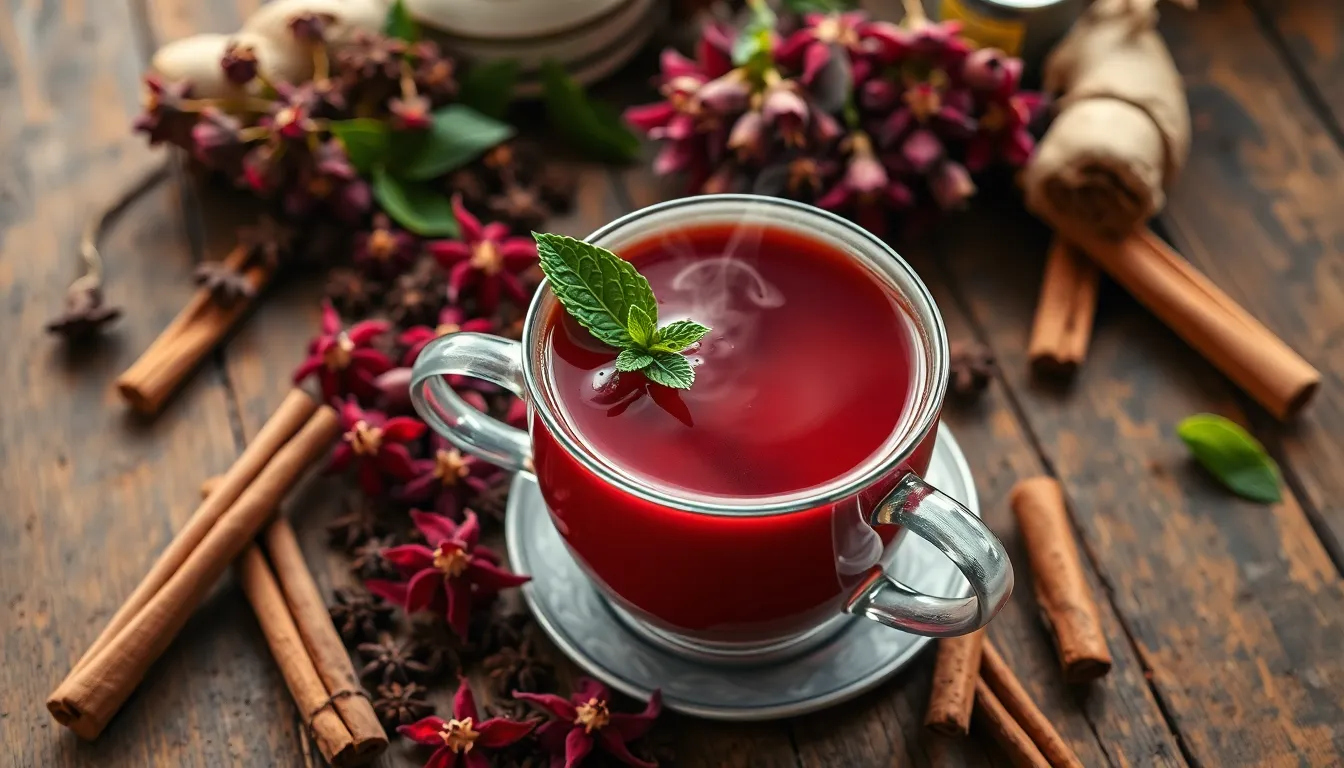
This warming spiced version transforms traditional hibiscus tea into an aromatic chai blend that combines floral tartness with exotic spices. We create a comforting beverage that delivers both wellness benefits and complex flavors perfect for cooler weather.
Ingredients
- ½ cup dried hibiscus flowers
- 4 cups filtered water
- 1 teaspoon ground cinnamon
- ½ teaspoon ground ginger
- ¼ teaspoon ground cardamom
- Honey or sugar to taste
- Optional: ¼ teaspoon ground cloves
- Optional: ⅛ teaspoon ground nutmeg
- Fresh mint leaves for garnish
Instructions
- Boil the water in a medium saucepan over high heat until it reaches a rolling boil.
- Add hibiscus flowers and spices to the boiling water, stirring gently to combine all ingredients evenly.
- Reduce heat to low and let the mixture simmer for 2-3 minutes to release the spice oils.
- Remove from heat and cover the saucepan to trap the aromatic steam during steeping.
- Steep for 15-20 minutes to allow the hibiscus flowers to infuse their deep red color and the spices to meld together.
- Strain the tea through a fine-mesh strainer or cheesecloth to remove all flower petals and spice particles.
- Sweeten to taste with honey or sugar while the tea is still warm for better dissolution.
- Serve immediately as a hot beverage or allow to cool completely before refrigerating for iced service.
- Garnish with fresh mint leaves and serve in your favorite mugs for an authentic chai experience.
Hibiscus Berry Tea Recipe
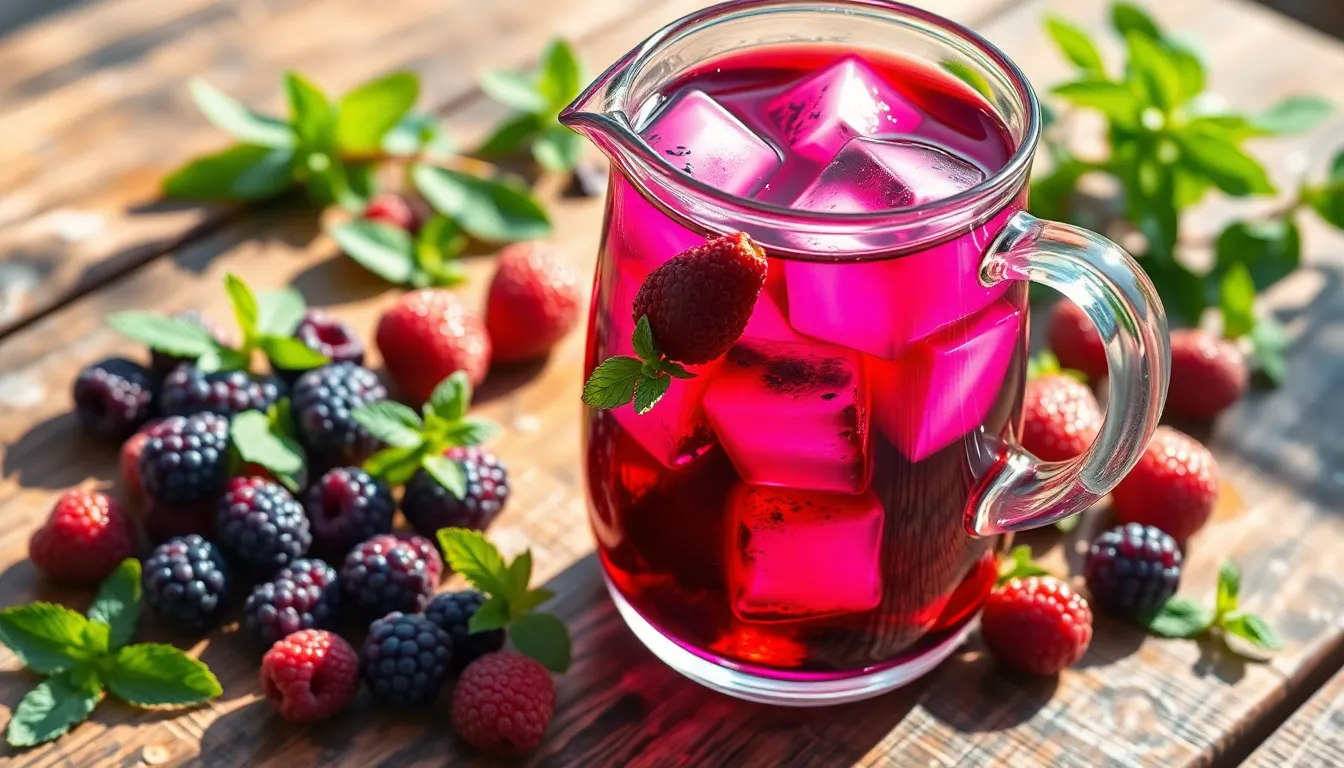
We’re taking our hibiscus tea journey to the next level with this berry-infused variation that combines the floral tartness of hibiscus with the sweet richness of mixed berries. This vibrant blend creates a stunning purple-red beverage that’s as beautiful as it is delicious.
Ingredients
- ¼ cup dried hibiscus flowers
- 4 cups cold filtered water
- 1 cup frozen mixed berries (raspberries, blueberries, blackberries)
- 2-3 tablespoons sugar or honey (optional)
- 1 tablespoon fresh lime juice
- Ice cubes for serving
- Fresh berries for garnish
- Fresh mint sprigs (optional)
Instructions
- Prepare the base tea: Combine dried hibiscus flowers with cold filtered water in a large pitcher. Allow the mixture to steep for 4-6 hours at room temperature or overnight in the refrigerator for a deeper flavor profile.
- Strain the hibiscus tea: Pour the steeped tea through a fine-mesh strainer into a clean pitcher. Press the hibiscus flowers gently to extract maximum flavor before discarding them.
- Add the berries: Place frozen mixed berries directly into the strained hibiscus tea. The frozen berries will naturally cool the tea while infusing it with additional berry flavors and nutrients.
- Infuse the berry flavors: Let the berries steep in the hibiscus tea for 30-45 minutes. Gently muddle a few berries against the side of the pitcher to release more flavor if desired.
- Sweeten and enhance: Stir in sugar or honey until dissolved. Add fresh lime juice to brighten the overall flavor and enhance the berry notes.
- Final preparation: Strain out the berries if you prefer a clear tea or leave them in for continued flavor infusion and visual appeal.
- Serve: Fill glasses with ice cubes and pour the hibiscus berry tea over the ice. Garnish with fresh berries and mint sprigs before serving immediately.
Make-Ahead Instructions
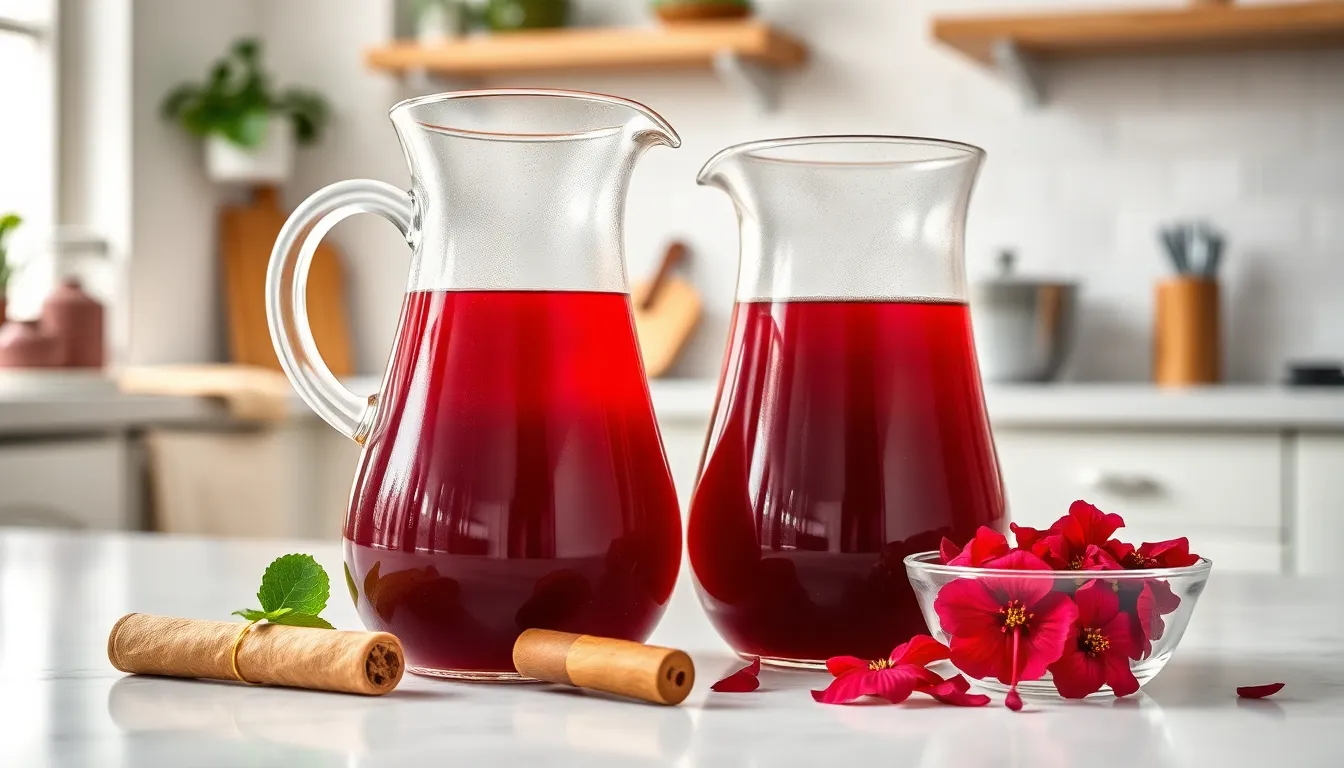
Planning ahead transforms hibiscus tea preparation into an effortless process. We can create concentrated tea bases that store beautifully and provide instant refreshment whenever needed.
Preparing Hibiscus Concentrate
We start by creating a potent hibiscus concentrate that serves as the foundation for multiple servings. Combine 1 cup of dried hibiscus flowers with 4 cups of boiling water in a heat-resistant pitcher or large teapot. Add 1 cinnamon stick and remove the mixture from heat immediately.
Allow the hibiscus flowers to steep for 2 to 8 hours or overnight for maximum flavor extraction. The longer steeping time creates a deep ruby concentrate with intense floral notes. Strain the mixture through a fine-mesh sieve into a clean container and discard the spent flowers and cinnamon stick.
This concentrate becomes our base for diluting with additional water when serving. We typically mix one part concentrate with one to two parts water depending on desired strength. The concentrate method allows us to prepare large batches efficiently while maintaining consistent flavor profiles.
Storage Tips
Fresh hibiscus tea keeps in the refrigerator for up to 5 days when stored properly. We store our prepared tea and concentrates in airtight glass containers or BPA-free plastic pitchers to preserve the vibrant color and prevent flavor absorption from other refrigerator contents.
Glass containers work best for maintaining the tea’s delicate floral notes and preventing any metallic taste that can develop in metal containers. Label containers with preparation dates to track freshness and ensure optimal flavor quality.
Our hibiscus concentrate stays fresh longer than regular strength tea due to its concentrated nature. Store concentrate in the refrigerator for up to one week and dilute portions as needed. This method reduces waste while providing convenient access to fresh hibiscus tea throughout the week.
Serving Suggestions
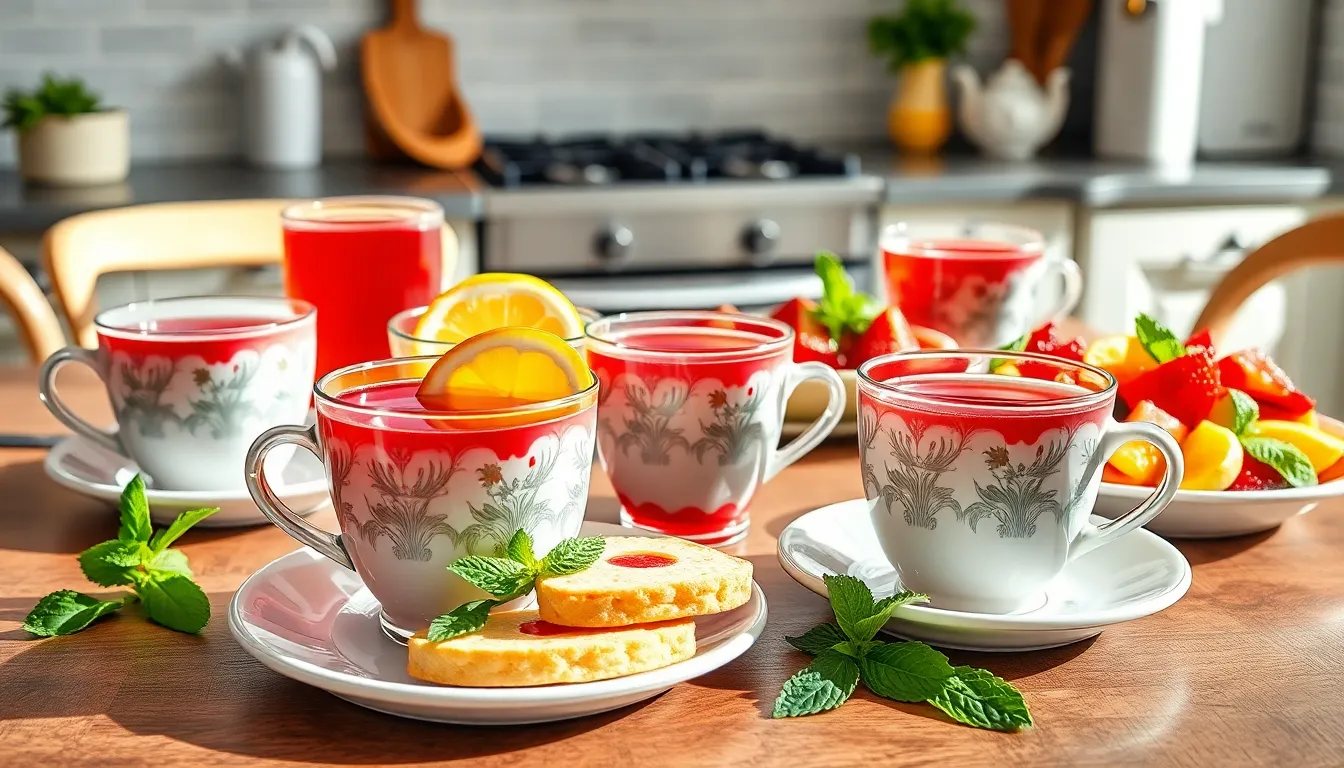
We’ve discovered that hibiscus tea’s versatility shines when paired thoughtfully with complementary foods and occasions. The key to maximizing enjoyment lies in understanding how this vibrant tea enhances different culinary experiences.
Hot Tea Pairings
Spicy Dishes create the perfect backdrop for hot hibiscus tea’s natural tartness. We recommend serving steaming cups alongside Mexican cuisine, Thai curries, or Indian dishes where the tea’s acidity cuts through rich spices and provides a cooling contrast.
Cakes and Cookies transform into cozy afternoon treats when accompanied by hot hibiscus tea. The floral notes complement vanilla-based desserts, while the tartness balances sweet frosting and rich chocolate flavors. We particularly enjoy pairing it with lemon bars, shortbread cookies, and almond cakes.
Pastries and Scones work beautifully during traditional afternoon tea service. The tea’s bright flavor profile enhances buttery textures while providing a refreshing alternative to traditional black teas. We suggest serving hot hibiscus tea with cream scones, fruit tarts, and delicate finger sandwiches.
Cold Tea Pairings
Fruit Salads receive a perfect complement from chilled hibiscus tea’s natural berry-like flavor. We’ve found that the tea’s tartness enhances fresh strawberries, peaches, and citrus fruits while providing a refreshing beverage that doesn’t compete with the fruit’s natural sweetness.
Grilled Meats benefit from iced hibiscus tea’s cooling properties and acidic balance. The tea cuts through smoky barbecue flavors and provides relief from spicy rubs and sauces. We recommend serving large pitchers with ice and fresh mint garnishes alongside grilled chicken, pork ribs, and beef brisket.
Brunch Dishes pair exceptionally well with cold hibiscus tea during weekend gatherings. The refreshing beverage complements avocado toast, quiches, and egg dishes without overwhelming delicate flavors. We suggest garnishing with lemon slices and serving in elegant glasses for an elevated brunch experience.
Tips for Perfect Hibiscus Tea
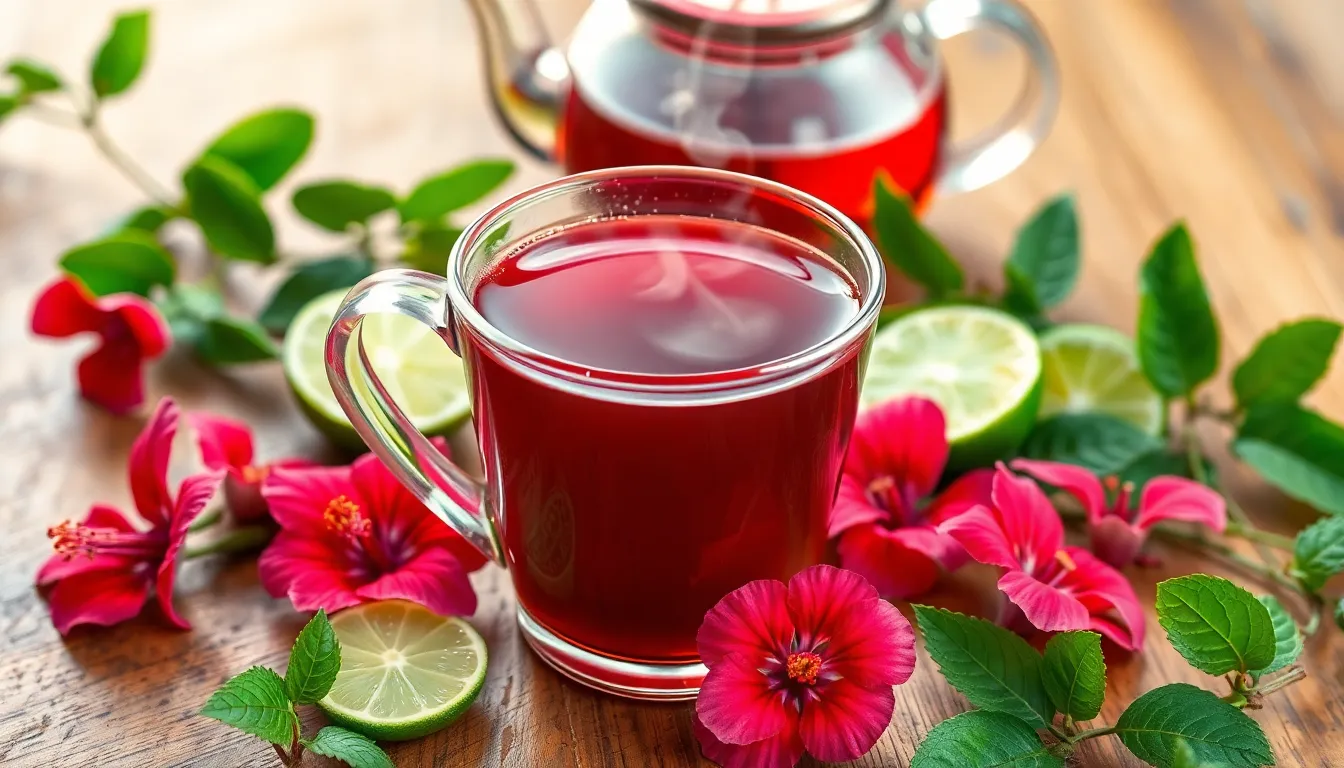
Mastering hibiscus tea brewing requires attention to timing and temperature for optimal flavor extraction. These proven techniques will help you create consistently delicious results every time.
Steeping Time and Temperature
We recommend heating water to approximately 200°F (93°C) for the best flavor extraction from hibiscus flowers. This temperature sits just below boiling point and prevents the delicate petals from becoming overly bitter while still drawing out their vibrant color and tart essence.
Steeping time directly impacts your tea’s strength and taste profile. We suggest starting with 5 minutes for a lighter floral tea that maintains subtle sweetness. For medium-bodied hibiscus tea we steep for 10-15 minutes to achieve balanced tartness and deep ruby color. When you prefer robust flavor we extend steeping up to 30 minutes though this creates intense tartness that may require sweetening.
| Steeping Component | Recommendation |
|---|---|
| Water Temperature | ~200°F (93°C) |
| Light Flavor | 5 minutes |
| Medium Flavor | 10-15 minutes |
| Strong Flavor | Up to 30 minutes |
Longer steeping times can produce bitterness so we always taste-test at the 15-minute mark before continuing. The flowers will continue releasing their essence throughout the steeping process creating that signature crimson hue.
Adjusting Flavor and Strength
We control hibiscus tea strength by adjusting the flower-to-water ratio rather than just steeping time. Adding more dried hibiscus flowers creates a more concentrated base while using fewer flowers produces a gentler brew that highlights the floral notes.
When your tea turns out too strong we simply dilute it with additional hot or cold water until reaching your preferred taste. This method preserves the beneficial compounds while creating the perfect balance for your palate.
Sweeteners play a crucial role in balancing hibiscus tea’s natural tartness. We add honey during the hot steeping process for seamless integration or stir in sugar while the tea remains warm. Agave nectar and maple syrup also complement the floral notes beautifully.
Citrus enhancement transforms hibiscus tea into a more complex beverage. We squeeze fresh lime or lemon juice into the finished tea to brighten the overall flavor profile. The citric acid also helps preserve the tea’s vibrant color during storage.
| Flavor Enhancement | Purpose |
|---|---|
| Honey/Sugar | Balances natural tartness |
| Lime/Lemon Juice | Brightens flavor and preserves color |
| Mint/Basil | Adds aromatic complexity |
| Lemongrass | Provides citrusy herbal notes |
Fresh herbs like mint basil or lemongrass create additional flavor layers when added during the final 5 minutes of steeping. We experiment with different combinations to discover your personal preferences and create signature blends that reflect your taste.
Troubleshooting Common Issues
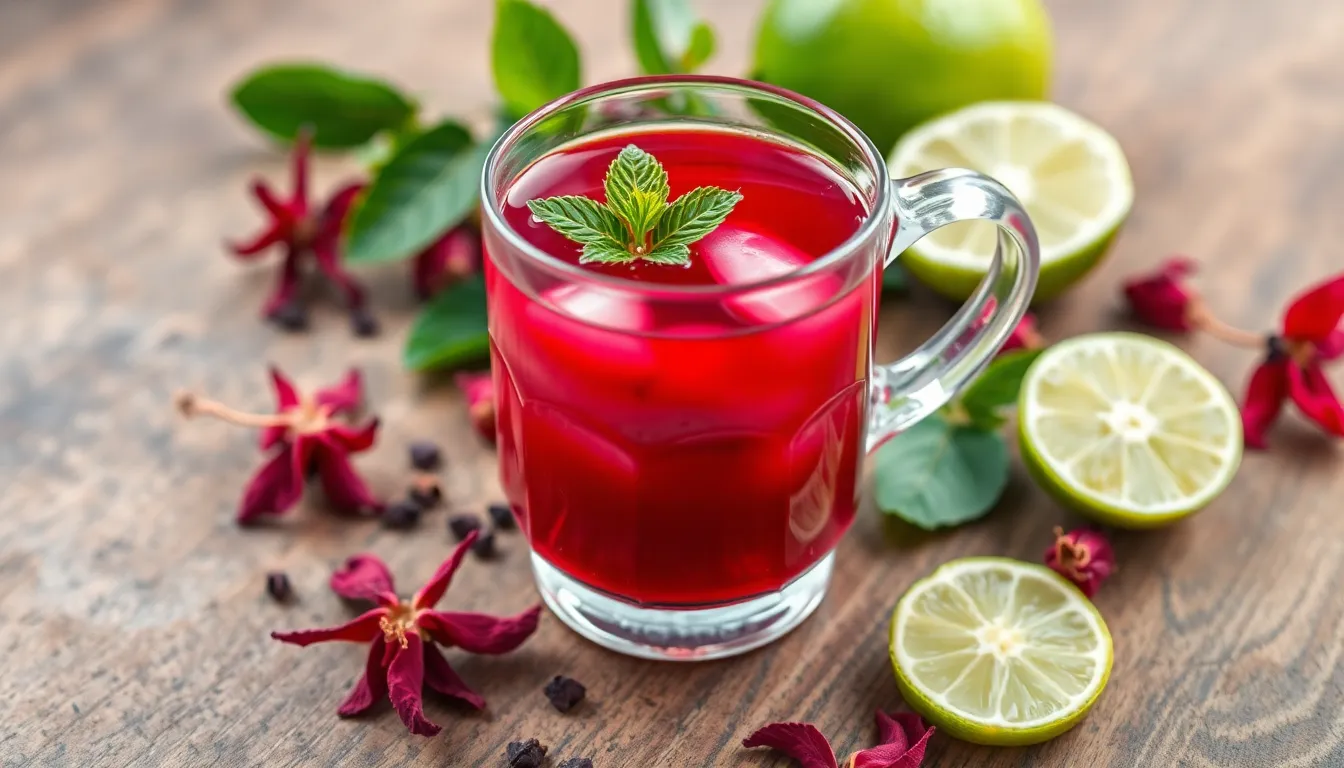
Even experienced tea brewers encounter challenges when preparing hibiscus tea. We’ve compiled answers to the most common problems that arise during the brewing process.
Bitter or Overpowering Flavor
Over-steeping creates the most frequent issue with hibiscus tea preparation. We recommend limiting steep time to a maximum of 20 minutes for hot tea preparations. Extended steeping beyond this timeframe extracts excessive tannins that produce an unpleasantly bitter taste. Cold brewing methods naturally avoid this problem since the lower temperature prevents over-extraction.
Reducing the amount of dried hibiscus flowers also helps control intensity. Start with less than the recommended ratio and gradually increase until you achieve your preferred strength.
Weak Color and Flavor
Insufficient hibiscus petals or inadequate steeping time results in pale, flavorless tea. We suggest using the proper ratio of hibiscus flowers to water as outlined in our recipes. For cold brewing methods, allow steeping time from 20 minutes to overnight for deeper color development and robust flavor extraction.
Fresh or low-quality dried hibiscus flowers may also produce weak results. Quality dried hibiscus should display deep burgundy color and strong aromatic properties when purchased.
Cloudy or Murky Appearance
Improper straining techniques cause cloudiness in the finished tea. We recommend using a fine mesh sieve or multiple layers of cheesecloth to remove all plant particles. Double-straining ensures crystal-clear results that showcase the tea’s beautiful crimson color.
Sediment from over-steeping can also create murky tea. Following our recommended steeping times prevents this issue while maintaining clarity.
Unpleasant Aftertaste
Balancing the natural tartness requires proper sweetening techniques. We suggest adding sweeteners gradually while the tea remains warm for better dissolution. Honey, agave nectar, or maple syrup complement hibiscus’s flavor profile more effectively than refined sugar.
Adding fresh lime or lemon juice creates balance and eliminates any lingering bitter notes. Start with small amounts and adjust according to your taste preferences.
Storage and Spoilage Issues
Brewed hibiscus tea requires proper storage to prevent mold and spoilage. We recommend refrigerating prepared tea immediately and consuming within 3 to 4 days for optimal freshness and safety.
Glass containers work best for storage since they don’t absorb flavors or odors. Avoid leaving brewed tea at room temperature for extended periods, as the natural sugars can promote bacterial growth.
Conclusion
We’ve explored the incredible industry of hibiscus tea and discovered countless ways to enjoy this vibrant caffeine-free beverage. From classic hot brews to refreshing iced variations these recipes showcase hibiscus tea’s remarkable versatility and health benefits.
Whether you’re drawn to the warming spices of chai blends or the cooling freshness of berry combinations there’s a hibiscus tea recipe perfect for every palate and occasion. The key lies in experimenting with different steeping times sweeteners and complementary ingredients to create your signature blend.
With proper brewing techniques and quality dried hibiscus flowers you’ll consistently create stunning crimson teas that deliver both exceptional flavor and impressive antioxidant benefits. Start with our basic recipes then let your creativity guide you toward new flavor adventures with this remarkable botanical treasure.
Frequently Asked Questions
What is hibiscus tea made from?
Hibiscus tea is made from the dried petals of the Hibiscus sabdariffa plant. These deep burgundy flowers are carefully harvested and dried to preserve their vibrant color and robust flavor. The tea is also known by various names including sorrel tea and agua de jamaica.
Does hibiscus tea contain caffeine?
No, hibiscus tea is completely caffeine-free. This makes it an excellent beverage choice for those avoiding stimulants and allows you to enjoy it throughout the day without worrying about sleep disruption or caffeine sensitivity.
What does hibiscus tea taste like?
Hibiscus tea has a naturally tart, cranberry-like flavor with floral notes. The taste is refreshingly acidic and slightly sweet, making it perfect for both hot and cold preparations. Its distinctive tartness can be balanced with sweeteners or citrus.
What are the health benefits of hibiscus tea?
Hibiscus tea is rich in antioxidants, particularly anthocyanins, which combat oxidative stress. Research suggests it may help lower blood pressure, reduce LDL cholesterol, support liver health, and act as a mild diuretic. It also aids digestion and promotes natural detoxification.
How long should I steep hibiscus tea?
For optimal flavor, steep hibiscus tea for 5-15 minutes in hot water (200°F/93°C). A 5-minute steep produces a lighter flavor, while 15-30 minutes creates a more robust brew. Adjust steeping time based on your preferred strength and taste.
Can hibiscus tea be served cold?
Yes, hibiscus tea is excellent served cold. You can brew it hot and chill it, or use cold brewing methods. Cold hibiscus tea is refreshing and perfect for hot weather, maintaining its vibrant color and delicious tart flavor when iced.
How much hibiscus flowers should I use per cup?
Use approximately 1-2 teaspoons of dried hibiscus flowers per cup of water, or follow the ratio of ½ to ¾ cup of dried flowers for every 6-8 cups of water for larger batches. Adjust the amount based on your desired strength.
How should I store brewed hibiscus tea?
Store brewed hibiscus tea in the refrigerator for up to 3 days in an airtight glass container. For hibiscus concentrate, it can last up to one week when properly stored. Always use clean utensils and containers to maintain freshness.
Can I mix hibiscus tea with other ingredients?
Absolutely! Hibiscus tea pairs wonderfully with ginger, mint, green tea, berries, and various spices. You can create blends like hibiscus chai, hibiscus lemonade, or hibiscus berry tea. Experiment with different combinations to find your favorite flavors.
Why is my hibiscus tea bitter?
Bitter hibiscus tea usually results from over-steeping or using water that’s too hot. To fix this, reduce steeping time to 5-10 minutes, use water at 200°F (93°C), and balance the tartness with natural sweeteners like honey or agave nectar.

